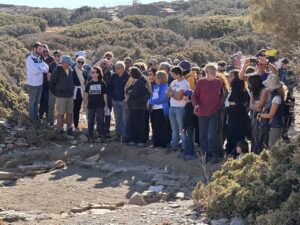by Irma Havlicek
Powerhouse Museum Web Producer

As if heat, high wind, a tough walk to and from the site and hard work on site aren’t enough (oh, and the odd snake or two), we find it is wasp season at Zagora. For joy. Most everybody else has been very calm about it, just waving them off. I am by nature not very calm about it, and generally make myself scarce where stinging flying things are concerned. Lunch sandwich ingredients (bread, sliced cheese and meat, cucumber, lettuce, tomato, beans, boiled eggs, mayo, etc. – kindly organised and prepared by Lea Alexopoulos – are laid out for us and we fill the bread with our preferred ingredients). For the first few days, we competed for lunch with the wasps. And not just a few wasps: a darn lot of wasps.
Then Hugh Thomas came up with this ingenious wasp trap: a 1.5 litre plastic bottle with lemon cordial and some sliced meat in the bottom, and a few small holes cut into the sides of the bottle. The wasps are attracted into the bottle, start to feast on the goodies at the bottom, and drown. Sorry, wasps. But it was you or us. Thanks, Hugh.


4 thoughts on “An ingenious wasp trap”
And so much better than using noxious sprays!
These sort of insect traps were once widely used. Here is an example of a glass fly trap in our collection – unfortunately not a good record – but it worked the same way. Sweet liquid used as the bait and the flies drowned. Alcohol works well as a bait too and the flies drowned even quicker!
http://www.powerhousemuseum.com/collection/database/?irn=263934
With alcohol as bait I’m guessing the flies drowned happier too!
You can do similar with a low, wide mouthed container for fruit flies.
Mix a little Apple Cider Vinegar (it must be this type), some liquid dish detergent, a teaspoon of honey, and some water. Put on the lid firmly. Shake well, to make a good head of foam. Remove the lid. The flies and any other small insects are attracted to the odour from the bursting bubbles. They land on a bubble, it pops, and they just fall in and get trapped and drown.
Thanks very much for that tip, Pewte. We’ll keep that idea in mind for use if we get bothered by small flying bugs.